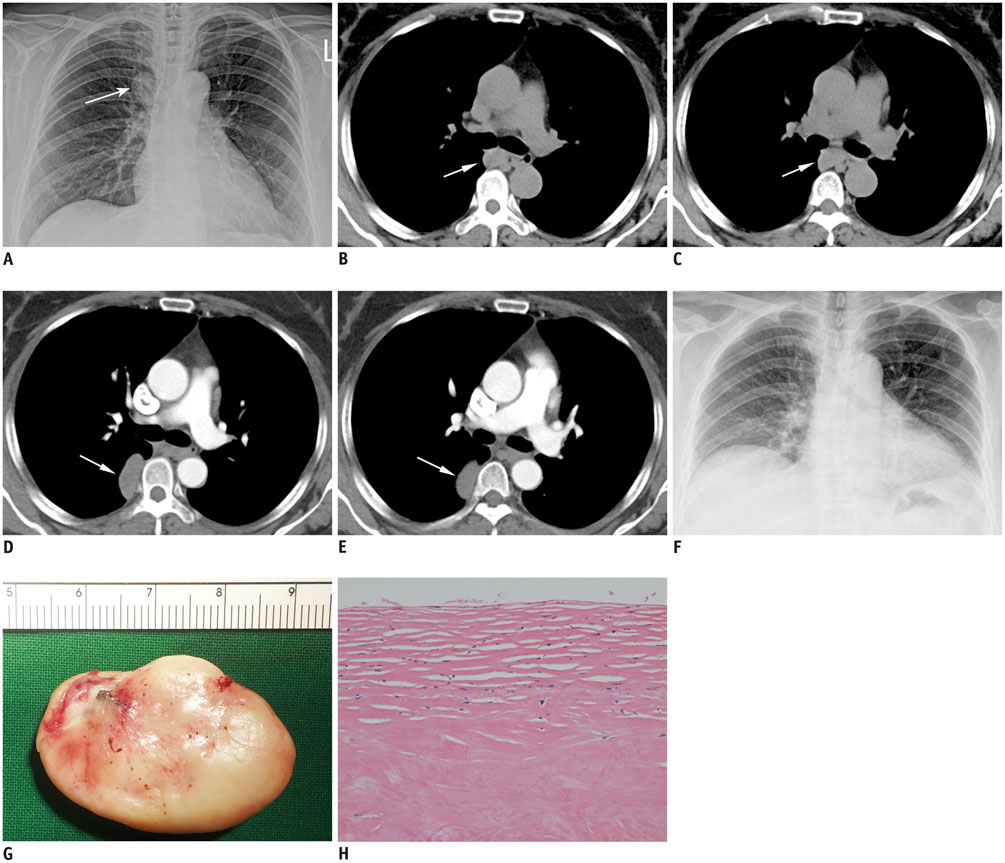Korean J Radiol.
2015 Oct;16(5):1163-1165. 10.3348/kjr.2015.16.5.1163.
A Pleural Loose Body Mimicking a Pleural Tumor: A Case Report
- Affiliations
-
- 1Department of Radiology, School of Medicine, Ewha Womans University, Seoul 07985, Korea. yookkim@ewha.ac.kr
- 2Division of Pulmonology and Critical Care Medicine in Department of Internal Medicine, School of Medicine, Ewha Womans University, Seoul 07985, Korea.
- 3Department of Thoracic and Cardiovascular Surgery, School of Medicine, Ewha Womans University, Seoul 07985, Korea.
- 4Department of Pathology, School of Medicine, Ewha Womans University, Seoul 07985, Korea.
- KMID: 2160784
- DOI: http://doi.org/10.3348/kjr.2015.16.5.1163
Abstract
- We present a rare case of a pleural loose body, thought to be a pedunculated pleural tumor, found incidentally in a 58-year-old female. Computed tomography showed a non-enhancing mass, which migrated along the mediastinum and paravertebral area. Thoracoscopic surgery revealed a 4 cm, soap-like mass that was found to be a fibrin body consisting of hyalinized collagen histopathologically. Mobility and the lack of contrast enhancement of a pleural mass are important clues to diagnosing this benign condition.
MeSH Terms
Figure
Reference
-
1. Bolca C, Trahan S, Frechette E. Intrapleural thoracolithiasis: a rare intrathoracic pearl-like lesion. Thorac Cardiovasc Surg. 2011; 59:445–446.2. Peungjesada S, Gupta P, Mottershaw AM. Thoracolithiasis: a case report. Clin Imaging. 2012; 36:228–230.3. Kinoshita F, Saida Y, Okajima Y, Honda S, Sato T, Hayashibe A, et al. Thoracolithiasis: 11 cases with a calcified intrapleural loose body. J Thorac Imaging. 2010; 25:64–67.4. Spitz WU, Taff ML. Intrapleural golf ball size loose body. An incidental finding at autopsy. Am J Forensic Med Pathol. 1985; 6:329–331.5. Kawanami T. [Post-thoracotomy "fibrin body": 16 year follow-up of a case (author's transl)]. Rinsho Hoshasen. 1980; 25:863–866.6. Euphrat EJ, Beck E. Fibrin body following traumatic pneumothorax; a problem in differential diagnosis of a nodular pulmonary density. Am J Roentgenol Radium Ther Nucl Med. 1955; 74:86–89.7. Dias AR, Zerbini EJ, Curi N. Pleural stone. A case report. J Thorac Cardiovasc Surg. 1968; 56:120–122.8. Iwasaki T, Nakagawa K, Katsura H, Ohse N, Nagano T, Kawahara K. Surgically removed thoracolithiasis: report of two cases. Ann Thorac Cardiovasc Surg. 2006; 12:279–282.9. Tanaka D, Niwatsukino H, Fujiyoshi F, Nakajo M. Thoracolithiasis--a mobile calcified nodule in the intrathoracic space: radiographic, CT, and MRI findings. Radiat Med. 2002; 20:131–133.10. Kosaka S, Kondo N, Sakaguchi H, Kitano T, Harada T, Nakayama K. Thoracolithiasis. Jpn J Thorac Cardiovasc Surg. 2000; 48:318–321.
- Full Text Links
- Actions
-
Cited
- CITED
-
- Close
- Share
- Similar articles
-
- Imaging Features of Various Benign and Malignant Tumors and Tumorlike Conditions of the Pleura: A Pictorial Review
- Pleural Calcification as a Manifestation of Paragonimiasis: A Report of Two Cases
- A Case of a Huge Mass Due to Pleural Metastasis and Management of Dyspnea in a Patient with Terminal Breast Cancer
- Diagnostic Tools of Pleural Effusion
- Intrathoracic Desmoid Tumor Mimicking Pleural Mass: A Case Report


